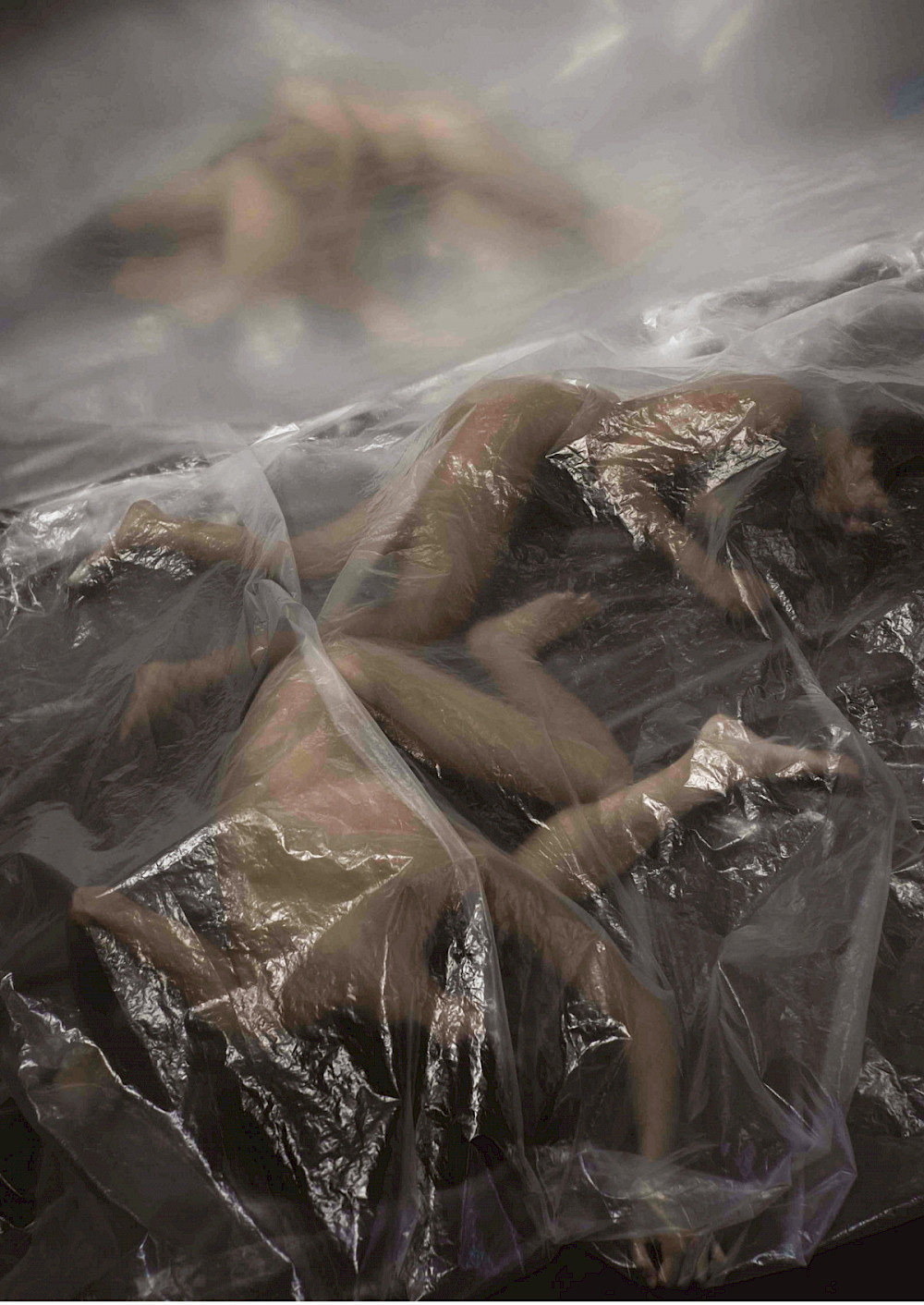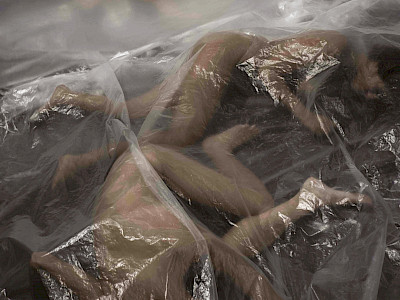10 — 13.05.2014
The artistic creations of Lia Rodrigues are emblematic of her political and social engagement. As the driving force of an arts centre in one of Rio’s largest favelas, the Brazilian chorographer makes no distinction between her dance and the heterogeneous society in which she implants herself. Pindorama was Brazil’s name before Portuguese colonisation. Pindorama is also the name of the final part of a trilogy that began with Pororoca (see Kunstenfestivaldesarts 2010). It describes a physical, sensorial, and spiritual landscape in constant transformation. With scant resources – a bare room, a plastic tarp, naked bodies, water – the choreographer evokes a torrent of images. A group of dancers moves between vulnerability and violence, between virginity and destruction. From solitary individuals, they evolve into a teeming crowd; they dream of a collective body as a shield against the fury of the elements. With this compelling ‘living installation’, Lia Rodrigues plunges us into a utopia.
Interview Lia Rodrigues (2013)
Pindorama is the third part of a trilogy that began with Pororoca and focuses on the question of the collective. What relationship is there between these different pieces? Is Pindorama bringing this cycle to a close?
A creation always begins a long time beforehand and finds its way internally before taking concrete shape. I was already thinking about this piece when I was working on the previous one – and I’d already the idea of a triptych in mind, like three connected objects. For me this piece is the third part of a triptych, but I still wouldn’t say that it’s bringing it to a close. Rather it’s opening up a new horizon, a new starting point. The word “trilogy” immediately makes me think of something heavy, very steady, like three blocks, while for me, the passages, the echoes, everything moving between these pieces is very fluid. That’s why I prefer talking about a triptych, like paintings whose motifs become merged and respond to one another. In practical terms, the main change in this piece concerns the dancers. I’m keeping 11 dancers – that seems a good balance for me for dealing with the issue of the collective – but this time, I wanted to have a new team. It’s about discovering and moving towards the other person. It’s risky, but exciting at the same time. So I did an audition based on the theme of Clarice Lispector’s work. I’ve run workshops about her in Brazil. What we did around her work really helped me enter into the creative process. The piece itself is not going to be based on Clarice Lispector’s books, but she’s a huge source of inspiration for me: she opens up an imaginary space. Her literature helps me embark on reflection.
Is this why you wanted to place the collective at the heart of the creative act again?
I’m interested in this question of the collective because it’s symbolic of my entire approach. It’s also a metaphor for the creative process that’s been part of my work in the Maré favela for almost ten years now, with the arts centre, dance school etc. All the relationships I’ve had to put in place, that have to be maintained to be able to be there – all the people you have to work with – none of that can work except with a certain idea of the collective that consists of hope, compromise, discussions and energy. This question looms so large in my life on a day-to-day basis that I need to give shape to it in another way through dance. Basically it’s always a work in progress! The triptych is a response to this need for elaboration. And when I say that the piece is not bringing things to an end, I mean that it’s also opening up new ideas, new practices outside the show: it’s opening up to reality. The main link between these pieces is of course the question of the relationship with the other: how to be yourself while remaining in a relationship with others and how that changes your relationship with yourself. There is a word in Portuguese which is a verb form of the word “other”: outrar. It means to be other, to go towards the other, to be in relation to the other, and this verb perfectly describes the type of relationship we’re looking for in this piece.
The three pieces in the triptych begin with a “p”. Is that just by chance or is there a reason for it?
When I created Piracema, the second piece, it was completely accidental. It was only afterwards that I realised that the three pieces begin with a “p”. Perhaps it’s a particular feature of the Tupi language spoken by the native people of Brazil – the three words come from this language. For Pindorama, the process was slightly different: I chose this title because of its significance for me. And it came to me a lot earlier than usual. Usually the title comes very late in the creative process, it comes to crystallise something. Here I needed its significance to embark on the work.
The word came first, as if it already formed a landscape? What significance does the word have for you?
The word landscape is very apt, and that’s what Pindorama made me think of. It was Brazil’s name before the Portuguese arrived. I read something written by a Brazilian historian who said that when the Portuguese arrived in their caravels along the coast, they initially described an “empty land”. In fact there were five million people living here in a way that the colonisers were incapable of seeing. What they saw as an empty land was an inhabited, cultivated land. This is a very important metaphor for me: it’s the idea that when we don’t recognise something, we don’t see it. When you don’t recognise the other person’s culture, the other person doesn’t exist. Either the difference is denied or it constitutes a threat that needs eradicating. What can you do in an empty country? You can do anything. Anything’s possible! The people living there are nothing, they’re inferior. The inhabitants’ culture, subjectivity, creation is completely denied. For me, it all functions like a strong metaphor for thinking about the other person. Where does this desire for domination, for destruction come from, and how can something else be invented? On the other hand it led me to contemporary Brazil, and to the place that Brazil occupies in our imagination: abroad you have the feeling that the country’s growing, that everything’s fine. But the country is built on a very dangerous kind of economic bubble that could burst at any moment. The World Cup that’s due to be held here is a very good example of this: there’s plenty of money around, but for millions of people the situation is very complicated and inequalities are continually growing. I see it working here in the Maré favela. The area is starting to be “pacified” by the police, but in other respects people living here have nothing.
The idea of the “collective body” brought out in this project, as well as the invention of “rituals”, might in certain respects make people think of the work of the Brazilian artist Lygia Clark. Is she a reference for you?
It’s funny that you mention Lygia Clark. I showed a first “attempt” last week [in 2013, Ed.], a “state” of ongoing improvisations, and what we did was heavily inspired by Lygia Clark’s work. In particular the experiments I did on her work, The Tunnel, when I recreated it for an exhibition dedicated to her in 1998. Works of the body, participative art, biological architecture… all these notions she invented are very important to me; they run through and feed all my creations in one way or another. We tried to recreate the experience – in another way of course – of a great journey in a tunnel by leaning on other people’s bodies. We tried to find ritual actions that allowed us to bore a way through.
Basically the tunnel, this passage, is also a metaphor for the piece itself, which constitutes a passage to something else?
Yes, it could absolutely be seen like that. Afterwards, of course, we’re still at the research stage. It’s hard to know what the final piece will look like. I’m at the start of work with bodies. I’ve lots of images in my head, starting from these ideas – of emptiness, passage, landscape – but it’s always very different when it takes shape. I’d like to create some ephemeral landscapes – physical and mental landscapes – and work on all the nuances, all the possibilities of being together or of not being together.
In this view of landscape and incarnation of a collective body, are you going to design a set or will everything be carried directly by the dancers?
I think that like the other pieces, Pindorama will be as simple as possible in terms of space for aesthetic and financial reasons. I always try to make pieces that can be produced and staged in my space, in Maré, where there is practically nothing, no lights, no sets… I start from that void even if there are eleven dancers, which is already fairly large… For Pororoca, my idea was that the entire piece could be put in a suitcase so that it could travel anywhere in Brazil – even in places with no technical equipment. For me, from a political point of view, it’s very important given the situation of dance in Brazil, which is very problematic. There’s not enough of it, there are too few spaces and it’s not seen enough. This work is therefore completely different from what I can do when I work in France. I want to do shows that can easily go to people. Nomadic pieces for collective bodies…
Interview by Gilles Amalvi for the Festival d’Automne à Paris 2013
English translation by Claire Tarring
Created by
Lia Rodrigues
Performed by
Amalia Lima, Leonardo Nunes, Gabriele Nascimento, Francisco Thiago Cavalcanti, Clara Castro, Clara Cavalcante, Felipe Vian, Dora Selva, Glaciel Farias, Luana Bezerra, Thiago de Souza, in collaboration with Gabriela Cordovez
Dramaturgy
Silvia Soter
Artistic collaboration
Guillaume Bernardi
Lighting
Nicolas Boudier
Stage manager
Magali Foubert
Photography
Sammi Landweer
Choreographic assistant
Amalia Lima
International distribution & production management
Thérèse Barbanel, Les Artscéniques
Production supervisor
Colette de Turville
Presentation
Kunstenfestivaldesarts, Kaaitheater
Production
Lia Rodrigues Companhia de Danças (Rio de Janeiro)
Co-production
Kunstenfestivaldesarts in collaboration with Kaaitheater (Brussels), Festival d’Automne à Paris, Théâtre National de Chaillot (Paris), Théâtre Jean-Vilar de Vitry-sur-Seine, La Briqueterie Centre de développement chorégraphique du Val-de-Marne, King’s Fountain, Hellerau-European Center for the Arts (Dresden)
Residency
Théâtre Jean-Vilar de Vitry-sur-Seine, supported by Conseil Régional d’Ile-de-France
Lia Rodrigues Companhia de Danças is supported by
Petrobrás & Ministry of Culture Brazil, in the framework of Petrobrás Cultural
In partnership with
Redes da Maré


